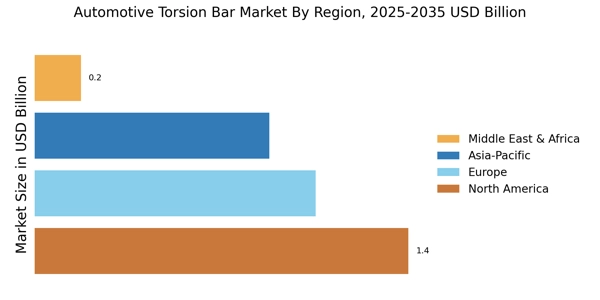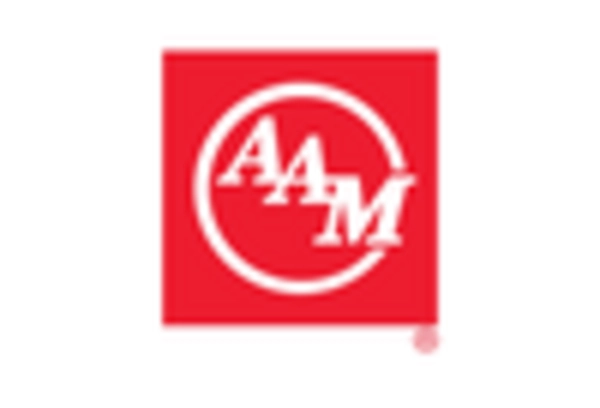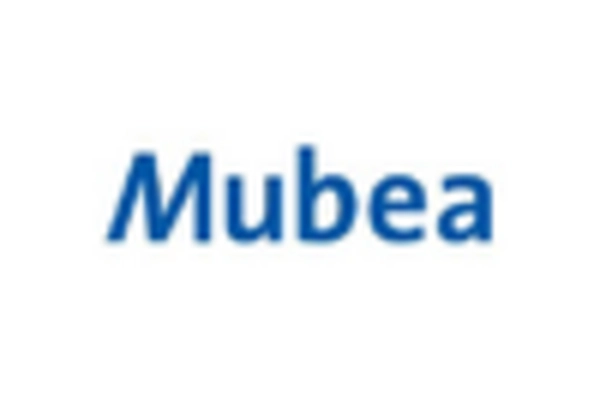Rising Adoption of Electric Vehicles
The Automotive Torsion Bar Market is poised for growth due to the rising adoption of electric vehicles (EVs). As the automotive landscape shifts towards electrification, manufacturers are increasingly incorporating torsion bars into EV designs to optimize weight distribution and enhance ride quality. Torsion bars provide a compact and efficient solution for suspension systems, which is particularly beneficial for EVs that require innovative engineering to maximize battery efficiency and range. Market data suggests that the EV segment is expected to grow at a compound annual growth rate (CAGR) of over 20% in the coming years. This growth presents a significant opportunity for the automotive torsion bar market, as manufacturers seek to develop lightweight and high-performance components tailored for electric drivetrains.
Increasing Demand for Fuel Efficiency
The Automotive Torsion Bar Market is experiencing a notable surge in demand for fuel-efficient vehicles. As consumers become more environmentally conscious, manufacturers are compelled to innovate and enhance vehicle performance while reducing weight. Torsion bars, known for their lightweight properties, play a crucial role in achieving these objectives. The integration of torsion bars in suspension systems allows for improved handling and stability, which are essential for fuel-efficient designs. According to recent data, vehicles equipped with advanced suspension systems, including torsion bars, can achieve up to 15% better fuel economy compared to traditional systems. This trend indicates a growing preference for torsion bars as automakers strive to meet stringent fuel efficiency regulations and consumer expectations.
Growing Focus on Vehicle Safety Standards
The Automotive Torsion Bar Market is also driven by the growing focus on vehicle safety standards. As regulatory bodies implement stricter safety regulations, manufacturers are compelled to enhance the structural integrity and performance of their vehicles. Torsion bars contribute to improved vehicle stability and control, which are critical factors in meeting safety requirements. The integration of torsion bars in suspension systems helps in maintaining optimal tire contact with the road, thereby reducing the risk of accidents. Market analysis indicates that vehicles with advanced torsion bar systems are more likely to pass safety tests, leading to increased consumer confidence. This heightened emphasis on safety is likely to propel the demand for torsion bars in the automotive sector.
Technological Advancements in Suspension Systems
The Automotive Torsion Bar Market is significantly influenced by technological advancements in suspension systems. Innovations such as adaptive suspension technologies and active damping systems are increasingly being integrated into modern vehicles. Torsion bars, with their inherent ability to provide consistent performance under varying loads, are becoming a preferred choice for manufacturers looking to enhance vehicle dynamics. The market is witnessing a shift towards more sophisticated suspension solutions that utilize torsion bars to improve ride comfort and handling. Recent studies indicate that vehicles equipped with advanced torsion bar systems can achieve a 30% improvement in ride quality. This trend underscores the importance of torsion bars in the evolution of automotive suspension technologies.
Expansion of Automotive Manufacturing in Emerging Markets
The Automotive Torsion Bar Market is benefiting from the expansion of automotive manufacturing in emerging markets. Countries with developing economies are witnessing a surge in vehicle production, driven by rising disposable incomes and urbanization. This growth presents a lucrative opportunity for torsion bar manufacturers, as automakers in these regions seek to enhance vehicle performance and affordability. Torsion bars, being cost-effective and efficient, are increasingly being adopted in various vehicle segments. Recent reports indicate that automotive production in emerging markets is expected to grow at a CAGR of 10% over the next five years. This trend suggests a robust demand for torsion bars, as manufacturers aim to meet the needs of a burgeoning consumer base.


















Leave a Comment